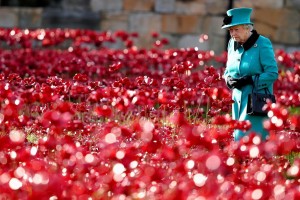WSJ Historically Speaking: London’s WWI Exhibit and Other Memorable Memorials
One of the most beautiful and sublime war memorials in modern history, the ceramic sea of poppies around the Tower of London, will vanish forever in two weeks’ time. The temporary installation, “Blood Swept Lands and Seas of Red” by artist Paul Cummins and designer Tom Piper, has attracted more than 4 million visitors since volunteers began “planting” the 888,246 poppies in early August—one poppy for each British or Commonwealth soldier who died.
The universal chorus of praise enjoyed by “Blood Swept Lands” is an important reminder that art and commemoration aren’t incompatible. Although it is no easy task to capture the tragedy of death or the essence of personal greatness, it can be done.
That said, public memorials are a notoriously sensitive business, and the result often ends in tears—if not for the artist, then for the public. Lord Byron thought the whole enterprise was a bad idea, especially when it came to commemorating public figures. “What is the end of Fame?” he asked in his poem “Don Juan.” “To have, when the original is dust, / A name, a wretched picture, and worse bust.”
Byron may have been influenced by the public scandal that surrounded the 1822 unveiling of Richard Westmacott’s statue in honor of the duke of Wellington. Westmacott created an 18-foot bronze colossus featuring Achilles in all his naked glory. It was the first nude statue in London since Roman times. The outcry was so great that the artist meekly added a fig leaf, thereby ruining the classical purity of the statue and making it seem more pornographic rather than less. Since then, the statue has been vandalized twice—in the predictable place.
Ten years after the Wellington debacle, Congress commissioned Horatio Greenough to make a memorial to George Washington that would be placed in the rotunda of the Capitol. Greenough decided, like the unfortunate Westmacott, to use Greek classical sculpture as his inspiration. The result was a fiasco: Greenough carved a near-naked Washington sitting on a throne, his feet sporting a pair of Birkenstock-like sandals, his right arm pointing bizarrely toward the sky. The statue lasted a year before national ridicule forced its removal from the Capitol.
But Westmacott and Greenough had it easy compared with the modernist sculptor Jacob Epstein, whose public works are among the most vandalized of the 20th century. Whether it was his tomb for Oscar Wilde in Paris’s Père Lachaise Cemetery, his facade for the British Medical Association building or his celebration of a fictional heroine named Rima, Epstein had an uncanny ability to offend.
Although largely forgotten today, Rima was the much-loved protagonist of the 1904 novel “Green Mansions,” by W.H. Hudson. Epstein infuriated fans by depicting her bare-breasted, in the modern-primitive style. The bas-relief was attacked repeatedly, including being tarred and feathered in 1929.
The public’s unrelenting hostility to the monument forms part of the London backdrop in Samuel Beckett’s avant-garde novel “Murphy.” The eponymous antihero takes a walk across Hyde Park, where he sees “a guffawing group…watching Rima being cleaned of a copious pollution of red permanganate.” Park authorities finally solved the Rima problem by erecting a tall iron railing around the statue.
Epstein’s once-reviled Wilde memorial in Paris is also surrounded by a protective barrier. A glass wall, erected in 2011, now keeps the tomb safe—not from attack but from kisses, thousands of which have worn away the stone. The moral of the story: It is never too late to become a national treasure.

